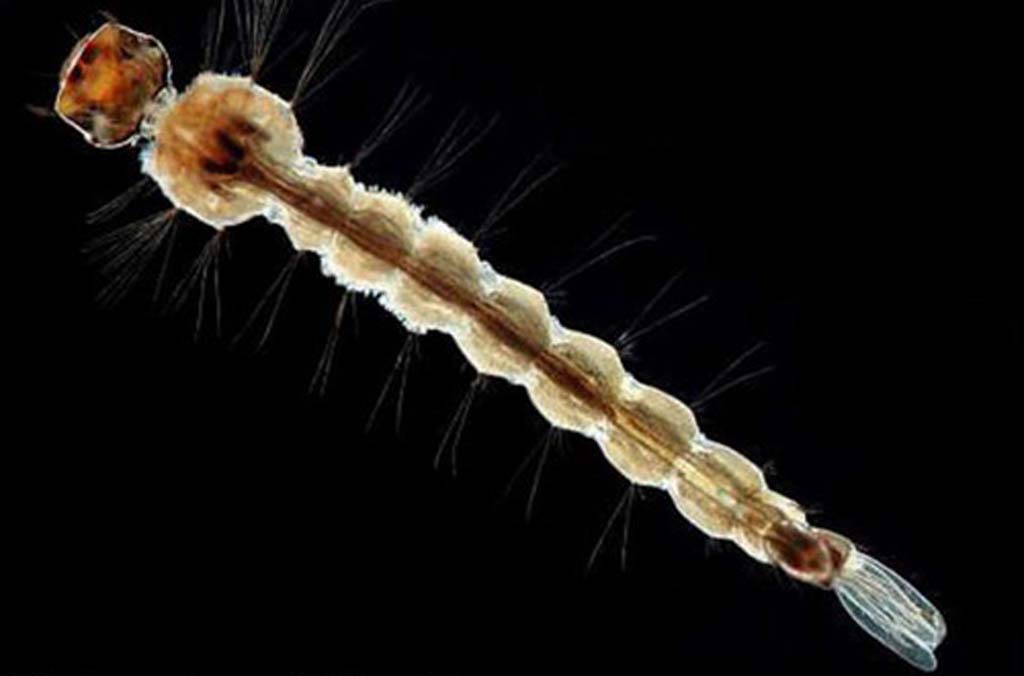ESCONDIDO — A move by a “heads up thinking” staff member of the county’s Vector Control team made it possible to identify and confirm the presence of an invasive mosquito species in the North County earlier this week.
Chris Conlan, a supervising vector ecologist with Vector Control, said a resident’s complaint brought the investigation of the mosquito larvae to the downtown area of Escondido off of East Valley Parkway.
Before investigators arrived at the home, the resident had dumped the standing water out of the potter, destroying the larvae in the process.
The staff member, on a hunch, grabbed some blocks of wood that was suspending the then-emptied potted plant where the larvae were found.
The hunch paid off. Some of the mosquito eggs were still attached to the wood.
Bringing the wood back to the Vector Control office, they placed it into some water and they got the larvae to hatch out of there, Conlan said.
“We actually had to get these larvae to hatch and get them up to size a little bit to make a positive identification,” Conlan said.

The confirmation marks the first time the Aedes aegypti species (also known as the yellow fever mosquito) has been discovered in the North County. It had been found in the county previously last October in the Chula Vista and Barrio Logan areas.
One adult mosquito was found inside of the Escondido resident’s home during the complaint investigation, Conlan said, but it was too badly degraded to get a positive identification.
“Unlike many of our native species, the yellow fever mosquito is quite content to come inside, and if it finds a breeding source inside, it will actually lay eggs, and start to do that in homes, businesses, garages,” Conlan said.
Since the discovery, Vector Control has been placing traps around the area, though with the cooler weather earlier in the week, Conlan said they didn’t expect to garner too much success with them.
“As it gets warmer and warmer that increases the chances of us perhaps catching an adult, if there are plenty of them out there,” he said. “Because we’re still at the very, very beginnings of this, we’ve only found them in one spot, and staff had gone out and canvassed a lot of the properties in the area, and found a number of small sources that are breeding, but so far they’ve just been native species,” he said.
While going around and putting spray out is just not very effective, Conlan explained, the best preventative measures are for residents to dump out all small sources of standing water.
“In this particular instance, we’re really going to have to rely very heavily on public outreach and teaching the general public,” he said.
If that doesn’t happen, he said, it would make getting rid of this mosquito exceptionally difficult.
As for any future prevention tactics, Conlan said first they’d have to ascertain how widespread the particular issue is.
“We don’t know if this is the one lucky chance find, and by dumping that water out we fixed it, or perchance they are a bit more pervasive in that particular area. We have to ascertain that first.” Once they’ve done that, they can begin to devise a strategy of how much they deploy towards public outreach versus door-to-door — having technicians going around and actually looking for these sources on people’s properties.
The mosquito can carry serious diseases as yellow fever, dengue and chikungunya, according to county environmental health officials.
At the end of February, the California Department of Public Health (CDPH) issued an alert, urging the public to protect themselves against mosquito bites and mosquito-borne diseases if traveling to Mexico or Latin America.
According to the CDPH, these regions reported increased chikungunya and continued dengue transmission in 2014, and reported cases of these mosquito-borne diseases among travelers returning to California have increased. Dengue and chikungunya viruses are transmitted by Aedes aegypti and Aedes albopictus mosquitoes.
Whether the drought is having any affect on the mosquito population numbers is hard to say at this point, Conlan explained, but he urged if residents are engaging in drought prevention efforts such as capturing rain water in open containers, to use the water right away.
During the recent canvassing of the Escondido area, the Vector Control teams found some rain barrels with open tops. Conlan said that that only gives those mosquitoes free reign to lay eggs.
The mosquito’s appearance is small and black with white stripes, feeds during the day and is an aggressive biter, according to the county. It prefers urban areas, including inside homes and businesses in areas that contain water such as plant saucers, cups and flowerpots.
To report neglected swimming pools or areas of standing water that could be sites of mosquito breeding areas call Vector Control (858) 694-2888 or email at [email protected].


